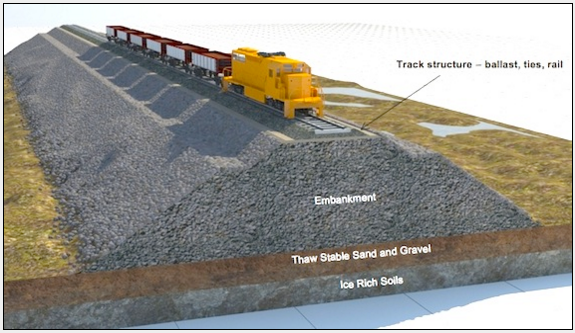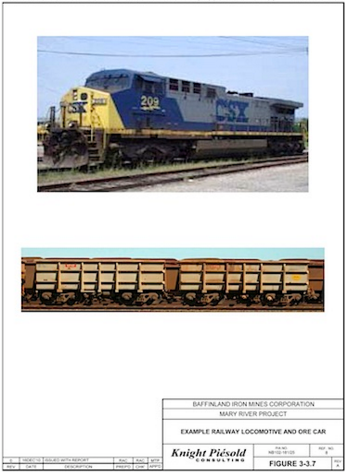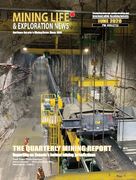Baffinland pitches Mary River-Milne Inlet railway for Nunavut iron mine
Change of plan catches Qikiqtani Inuit Association by surprise
 |
| This illustration from Baffinland's original environmental impact statement, which proposed a railway from Mary River to Steensby Inlet, shows the kind of embankment that would have to be constructed for an Arctic railway to deal with permafrost. They're now proposing a railway that would follow a different route: Mary River to Milne Inlet. |
 |
| This illustration from Baffinland's first EIS shows the kind of locomotive that Baffinland proposed using in its first railway proposal, a routed heading south from Mary River to Steensby Inlet. They're now proposing a railway from Mary River north to Milne Inlet. |
Baffinland Iron Mines Corp. has proposed the construction of a railway from its Mary River mine on north Baffin to Milne Inlet as part of its Phase II expansion proposal in a Feb. 17 announcement which likely surprised its Nunavut stakeholders.
“Baffinland has determined the incorporation of a railway is an integral facet of the Phase 2 proposal due to a number of environmental, technical and economic benefits,” a letter from the mining company to the Nunavut Impact Review Board said.
That means Baffinland will have to push back the submission of an environmental impact statement to the review board from this April to September, the letter said.
Justin Buller, assistant director of major projects for the Qikiqtani Inuit Association, announced the news at a board of directors meeting Feb. 18 in Iqaluit.
The letter later appeared on the NIRB’s public registry.
“They haven’t been too explicit on their reasons [for the proposed rail line],” Buller told the QIA board members.
Some directors reacted with surprise and concern at the lack of information and yet another change in plans for the Mary River mine.
“They’re not thinking about the land or the people. Where do we draw the line?” a board member said.
“We need to think about this proposed change in that way as we move forward,” QIA president Pauloosie (PJ) Akeeagok replied, adding he hoped to get more information and clarity from Baffinland on the proposed rail line.
Baffinland shipped its first load of iron ore from Mary River via Milne Inlet in August 2015 as part of its “early revenue” phase.
Global prices of iron ore have plummeted since the NIRB first granted the company its Mary River project certificate in 2012.
For that reason, and because the iron ore market is a high-volume, low-margin business, the company has changed its plans for Mary River considerably a number of times.
The original proposal called for a $5-billion railway to be built from the mine south to Steensby Inlet on the Foxe Basin side of Baffin Island — a plan shelved by Baffinland due to its high price tag.
Instead, the company began transporting iron ore along a 100-kilometre tote road between the mine and Milne Inlet, near Eclipse Sound on Baffin’s northeast shore.
And then in late 2014, Baffinland proposed significant changes to its project certificate, including:
• more than tripling truckloads of iron ore along the tote road to the Milne Inlet port;
• nearly tripling the output of iron ore from Milne Inlet, from 4.2-million tonnes to 12-million tonnes per year;
• increasing the shipping season from three or four months a year to ten months a year; and,
• building a second dock at Milne Inlet and a nearby tank farm capable of holding 140-million litres of fuel.
The NIRB decided in August 2015 that the proposed changes warranted a full public review, requiring Baffinland to submit a new Environmental Impact Statement.
Now that Baffinland is aiming to submit its assessment in September, the review board won’t likely make a decision on the company’s proposed Phase 2 project until the spring of 2017.
That’s because after Baffinland makes its submission, the NIRB has to conduct community consultations and a technical review.
In the meantime, Buller said at the QIA’s board of directors meeting Feb. 18 that the Baffin Inuit organization will push ahead with its own community consultations on the mining company’s proposal and on a revamped Inuit Impact and Benefits Agreement.
The first round of community consultations took place in November 2015, Buller said, in the five communities most affected by Mary River: Clyde River, Pond Inlet, Igloolik, Hall Beach and Arctic Bay.
And Buller said QIA staff just completed a second round of radio shows in those communities seeking local input.
Monthly radio shows will follow, Buller said, but before the next set of call-in shows, the QIA will try to find out more details from Baffinland on the proposed rail route to Milne Inlet.
Buller pointed out that under the original project certificate, Baffinland was approved to build a rail line to Steensby Inlet, from which 18 million tonnes a year of iron ore from Mary River can be shipped.
In an update issued later on Feb. 18, QIA said Baffinland’s new Milne Inlet railway plan likely involves more changes to the Milne Inlet port, the shipping route from Milne Inlet, and the types of ships that may be used.
Source: http://www.nunatsiaqonline.ca/stories/article/65674baffinland_milne_inlet-mary_river_railway_for_nunavut_iron_mine/

|